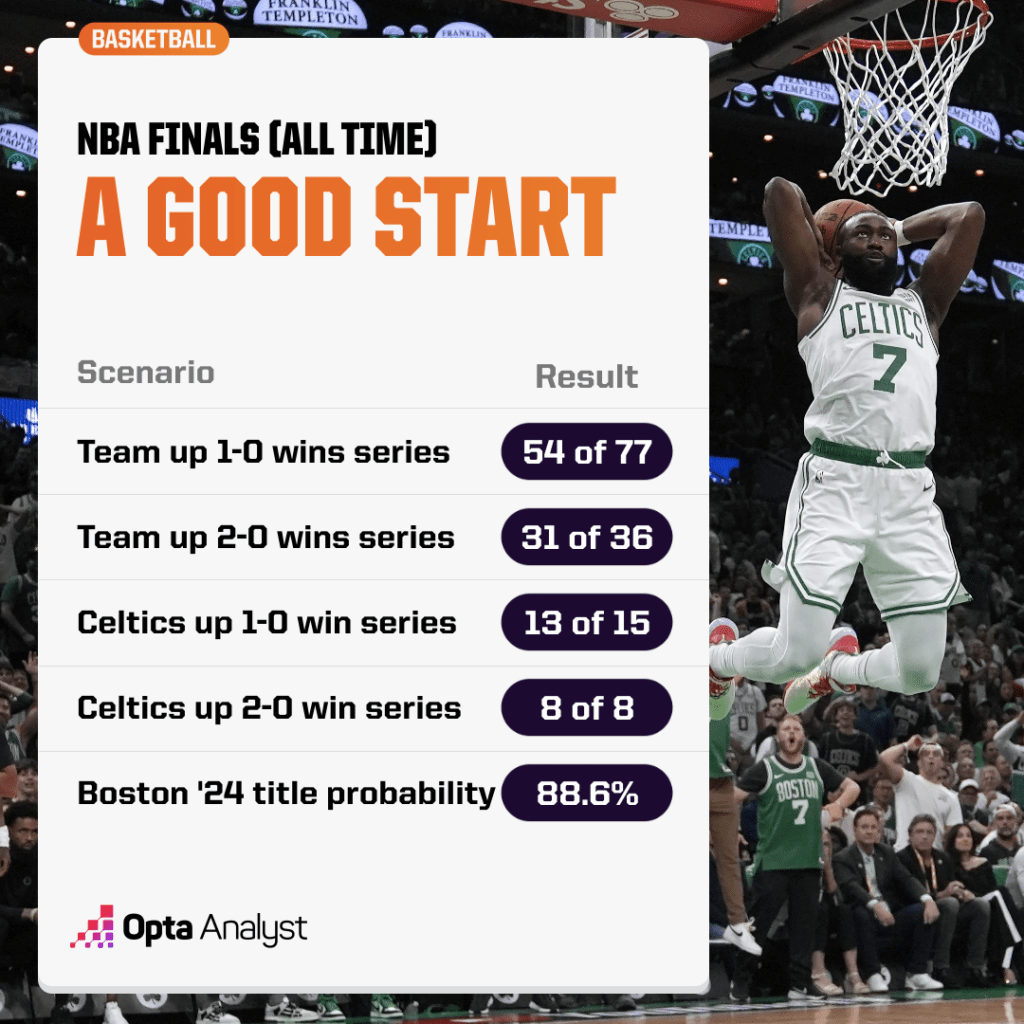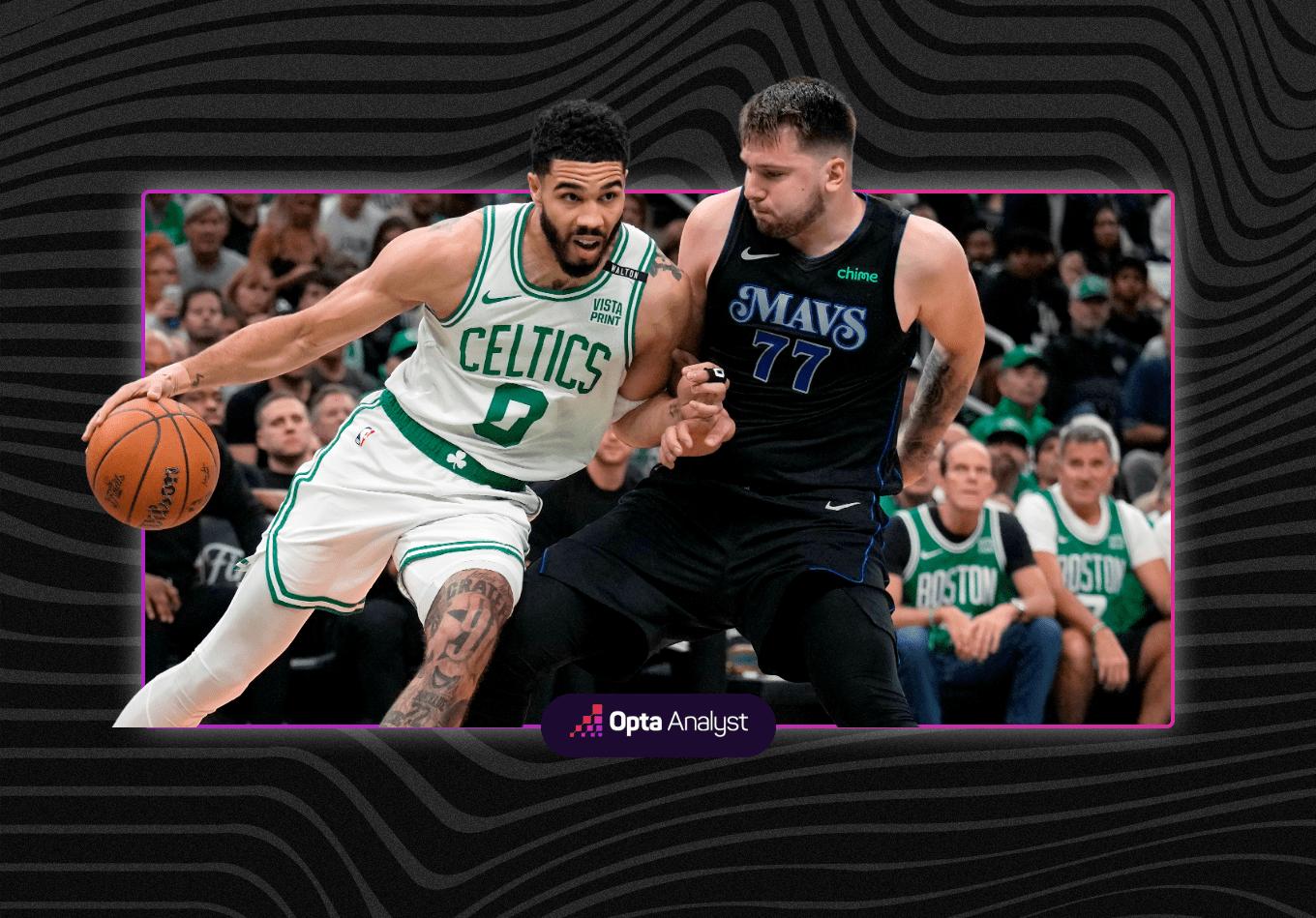After Boston opened the series in convincing fashion, we’re breaking down our Mavericks vs. Celtics Game 2 prediction and revealing the keys for each side.
107-89. And really, it didn’t seem that close.
After a week without basketball, the 2024 NBA Finals officially tipped off on Thursday night, with the Boston Celtics earning a convincing Game 1 victory over the Dallas Mavericks.
How did the Celtics earn such a dominant win? What did the Mavericks do wrong? Is there anything they can do to counter or is this series already over?
Let’s dig into those questions and our NBA Finals preview of Sunday’s Game 2 (on ESPN/ABC) back at the TD Garden.
The Celtics’ Spacing Matters
The biggest takeaway from Game 1 is that the Celtics just have so much more spacing than the Mavericks. Remember, in basketball, you need spacing to win. So, the more you can create on offense and the more you can take away on defense, the better your chances of victory.
The Celtics’ top eight players (the starting five plus Al Horford, Sam Hauser and Payton Pritchard) are all average/above-average 3-point shooters. That means that you can’t help off them (something the Mavericks really like to do) without paying a hefty tax. For instance, look at what happens when Daniel Gafford helps off Horford (first clip in the video montage below).
The Mavericks don’t have this same luxury. Two of Dallas’ key contributors – Derrick Jones Jr. and P.J. Washington – were in the 35th and 23rd percentile, respectively, in 3-point percentage. So, the Celtics have been helping off of them (as seen in the second clip) to protect the paint.
The kicker is that they don’t get burned for it the way that Dallas does.
Speaking of great spacers, former Maverick Kristaps Porzingis had a great first game back from injury. We have been on the Porzingis train all year long, but his impact really burned bright in the opener.
When he was on the floor (he only played 20 minutes as he was ramping back up), Porzingis was put on one of Dallas’ below-average shooting wings/forwards. This enabled him to sag off his assignment and safeguard the interior (first clip in the video montage below). And whenever one of those wings/forwards tried to make him pay for ignoring them, Porzingis emphatically denied their advances (second clip).
On offense, Porzingis used his dead-eye accuracy and ultra-quick trigger to burn the Mavericks’ defense from way downtown (third). And since Porzingis’ jumper is fast, accurate, and he launches 3s at a high clip (91st percentile in 3-point volume among centers), the Mavericks have really been respecting his perimeter prowess. That creates a more spacious paint for his teammates (fourth).
Lastly, since Porzingis is so titanic (7-foot-2), he can hunt smaller defenders in the post and simply just elevate over the top of them (fifth).
Despite his limited minutes, Porzingis dropped 20 points with six rebounds and three blocks on 72.1% true shooting and a plus-minus of +13 (it makes sense that he finished the regular season second on the team in DRIP). He epitomized the Celtics’ ability to create space for themselves and take it away from the Mavericks.
Along with the spacing battle, the Celtics also won the ball movement competition in Game 1 – out assisting the Mavericks 23-9. Considering the Mavericks employ the venerable floor general Luka Doncic, it wasn’t because the Celtics have the better passers. Rather, it was a byproduct of each team’s defensive processes.
The Celtics made it their life’s work to hunt Doncic whenever they could. This led to a ton of breakdowns at the point-of-attack, which forced the rest of the Mavericks’ defense to collapse and opened the door for Boston kick-out triples (first clip in the montage below).
Meanwhile, the Celtics did a great job of keeping the ball in front of them, which enabled their off-ball defenders to stay home on their matchups (unless they were instructed not to because they were guarding a non-shooter). This limited opportunities for assists and forced Doncic and Irving to spend a lot of time trying to score in isolation (second clip).
Also worth noting was the Celtics’ ability to switch pick-and-rolls effectively neutralized the lob passes to Dereck Lively II and Gafford that Doncic has typically accrued a high volume of assists from (third) in these NBA playoffs.
How the Mavs Can Strike Back
Game 1 made it very apparent that the Celtics (when fully healthy) are the vastly superior team on paper. With that said, that doesn’t mean that all hope is lost for Dallas.
When the Western Conference champions were down by 29 with a little over four minutes left in the second quarter, they went on a 35-14 run to cut the lead down to eight with four minutes left in the third (before Boston ballooned the lead back up to 22 shortly after).
For the game, the Celtics shot 16 of 42 (38.1%) from 3-point range. But during the stretch that we mentioned above, they shot just 2 of 11 (18.1%). The Celtics (especially with all their spacing) won’t shoot 18.1% from beyond the arc for the rest of the series, but they also won’t shoot the 45.2% they shot during the other parts of the game. The bottom line: If the Celtics cool off, the Mavericks have a much better chance in this series.
Another important part of that stretch was that Doncic looked much more comfortable. He had 19 points on 9-of-11 shooting during that run (he had 11 points on 3-of-15 shooting in the other parts of the game). Most of this was just Doncic hitting shots in the second and third quarters that he was missing at other points in the game.
But regardless, Dallas will need him at his best.
Speaking of missing shots, Kyrie Irving had an uncharacteristically rough shooting night, going 6 for 19 from the floor and missing all five of his 3-point attempts. Though Jrue Holiday is one of Boston’s best players defensively (third on the team with a 1.0 defensive DRIP), the Mavs should be able to count on better performances from Kyrie.
The big tactical wrinkle that the Mavericks can emphasize moving forward is their choice to make Jayson Tatum and Jaylen Brown beat them as decision-makers.
Something we examined in the series preview is that the Mavericks might try to shrink the floor on Tatum and Brown’s drives and force the tandem into difficult situations. In the Game 1, Tatum and Brown passed that test on numerous occasions (like this), but the Mavericks also got some key stops by leaning on this approach.
Just because Tatum and Brown did well against the paint overload in Game 1 doesn’t mean they will keep doing so throughout the series. (Brown had a team-high 22 points after earning Eastern Conference finals MVP honors against the Indiana Pacers.).
The Mavericks need to keep testing Tatum and Brown’s decision-making and make them prove that this is no longer an exploitable weakness.
Game 2: Who Has the Edge?
Our win probability model calculates each team’s chances of winning (in this case, the NBA Finals) based on thousands of simulations. Before Game 1, our model gave the Celtics an 81.9% chance of winning the series.
Now, after the results of Game 1, our model has increased Boston’s odds of hoisting the Larry O’Brien Trophy by 6.7%, meaning it now has an 88.6% chance of winning. The Celtics also have history on their side when it comes to teams that have won Game 1 (and will have an even bigger edge if they take Game 2).

However, that doesn’t mean that the clock has struck midnight on the Cinderella Mavericks. As the 5 seed in the West, they were at a disadvantage earlier in playoff games against the Los Angeles Clippers in the first round, Minnesota Timberwolves in the conference finals and Oklahoma City Thunder in the conference semifinals. You saw what happened in those series.
Now, let’s see if the underdog Mavs can pull off one more postseason surprise.
Be sure to check out all our MLB, NBA and NFL coverage, as well as our NHL Stanley Cup Final prediction. And follow us on X and Instagram for more!
